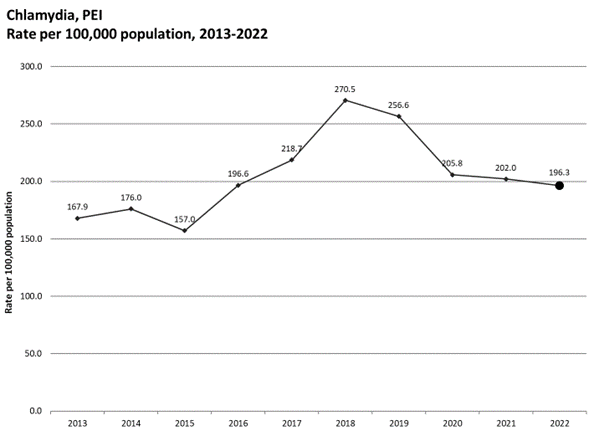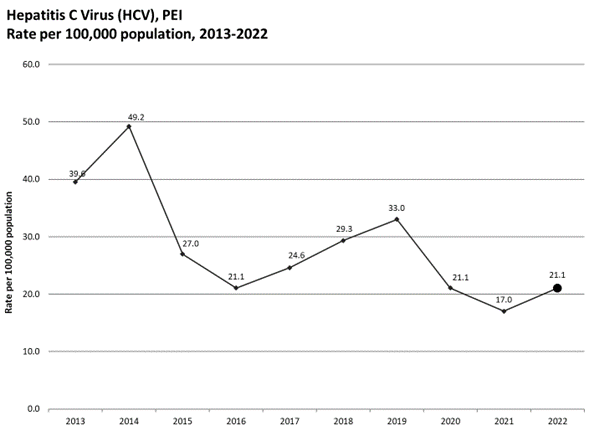Sexually Transmitted and Bloodborne Pathogens Infection Rates in PEI
The Chief Public Health Office is mandated by the Public Health Act and the Notifiable Diseases and Conditions and Communicable Diseases Regulations to control certain communicable diseases in PEI. The Communicable Disease Program contributes to this mandate through policy development, disease surveillance, case follow-up, contact tracing, immunization, education and reporting on STBBI rates.
Sexually Transmitted and Bloodborne Infections

Chlamydia

PEI – Chlamydia is the most commonly reported sexually transmitted infection in PEI. Rates of chlamydia infection in PEI began increasing in 2016 and peaked in 2018 with a rate of 270.5 cases per 100,000 population. In 2022, the rate of chlamydia infections in PEI was 196.3 cases per 100,000 population and this rate was not statistically different from the average rate in the most recent five years prior (i.e., from 2017 to 2021). Chlamydia is often under-diagnosed because the majority of infected individuals are asymptomatic.
Canada – Chlamydia is the most commonly reported sexually transmitted infection in Canada. Chlamydia rates have increased by 26% over the past decade in Canada. In 2020, a total of 105,982 cases of chlamydia were reported nationally, for a rate of 278.9 cases per 100,000 population.ii
Gonorrhea
PEI – The four Atlantic Provinces (NB, NL, NS, and PE) have held the lowest rates of reported gonorrhea cases in the country since 2013.ii The rate of gonorrhea in PEI has been slowly increasing since 2013. In 2022, the rate of gonorrhea was 12.3 cases per 100,000 population, which is three times the rate reported in 2013 (4.2 cases per 100,000 population).
Canada – In Canada, gonorrhea is the second most commonly reported STI after chlamydia. Of particular concern is the emergence of antibiotic resistant gonorrhea. Gonorrhea rates have increased by 171% over the past decade in Canada. In 2020, 30,833 cases of gonorrhea were reported nationally, corresponding to a rate of 81.1 cases per 100,000 population.ii
Hepatitis C

PEI – In 2014, PEI embarked upon a progressive approach for eliminating hepatitis C virus (HCV) that includes encouraging testing for individuals at high risk and providing new treatments through the Hepatitis C Drug Program. In 2015, the HCV rate in PEI dropped 12% below the national averageiii and continued to decline in 2016. An increase in the rate of HCV infections in PEI was observed between 2016 and 2019. More recently in 2022, the rate of HCV infections in PEI was 21.1 cases per 100,000 population and this rate was not statistically different from the average rate in the most recent five years prior (i.e., from 2017 to 2021).
Canada - In 2020, there were 6,736 reported hepatitis C cases in Canada. From 2014 to 2018, national hepatitis C rates rose by 14.5% from 29.7 to 34.0 per 100,000 population. However, from 2018 to 2020, the national rate dropped by 45.9% to 18.4 cases per 100,000 population. The most recent national surveillance update indicates that the COVID-19 pandemic reduced the demand for and access to services related to sexually transmitted and blood-borne infections, including harm reduction and testing. This likely impacted new hepatitis C diagnosis rates in 2020, by artificially reducing them.iv
Hepatitis B
Hepatitis B virus (HBV) infections are classified as acute or chronic infections. National rates are influenced by variations in which each province distinguishes HBV cases by infection status. In 2020, there were 123 reported acute hepatitis B cases were reported from 11 provinces and territories for a rate of 0.34 per 100,000 population. National acute hepatitis B rates are low and have plateaued since 2010, with annual case counts remaining under 200.iv Many provinces and territories implemented a universal HBV immunization strategy in the early 1990s aimed at infants and children, and this strategy is attributed with reducing acute HBV infections in this population. Additional decreases in rates may be achieved through improving immunization strategies for immigrants, refugees, and adopted children from countries without mass HBV vaccination programs.
HIV
PEI – In PEI, we typically see somewhere between 0 to 2 local HIV transmissions per year and many cases of HIV diagnosed in PEI resulted from an exposure that occurred outside of Canada and are not reflective of domestic transmission. In 2022, the rate of new HIV infection in PEI was 2.3 cases per 100,000 population and this rate was not statistically different from the average rate in the most recent five years prior (i.e., from 2017 to 2021).
Canada - In 2021, a total of 1,472 new diagnosed cases of HIV were reported which is an 11.3% increase since 2020. The national rate of new HIV diagnoses for 2021 was 3.8 cases per 100,000 population. It is expected that the COVID-19 pandemic has had an impact on observed new diagnosis rates for HIV in 2021.iv From 2010 to 2019, the number and rate of reported HIV cases in Canada has remained relatively stable over the last decade, with minor year-to-year variations.vii
Syphilis (Infectious)
PEI – Reported rates of infectious syphilis in PEI are generally low. In recent years, between 1 and 5 cases of infectious syphilis have been reported per year.
Canada - Infectious syphilis rates have increased by 389% between 2011 and 2019, the highest increase in rates of all three bacterial STI under surveillance. In 2020, a total of 9,358 cases of infectious syphilis were reported, for a rate of 24.6 cases per 100,000 population.ii
What are we doing?
- STI and STBBI testing at physician and nurse practitioner offices and at Health PEI Sexual Health Clinic, Options and reproductive Services (SHORS)
- UPEI Health & Wellness Centre(link is external) and Holland College health clinics are open for students 5 days / week and offer STBBI testing
- Development of STI education material and collaborating with community groups for increasing public awareness, specifically for populations at higher risk for STBBIs
- Prevention is provided with
- coverage for HIV Pre exposure prophylaxis (PrEP) and Post exposure prophylaxis (PEP) through the HIV program,
- the needle exchange program provides clean supplies for drug use to help prevent transmission of Hepatitis C, and
- Hepatitis B immunization available through the childhood immunization program and through the adult immunization program
- Medication for those diagnosed with an STBBI is covered under the STI Drug program, the Hepatitis C treatment program and the HIV program
- All people who are infected with a STBBI are provided confidential follow up with a Public Health Nurse. This follow up includes education and assessment for immunizations that the person may require.
- In late 2022 the PEI STBBI Reduction Action Plan was released and work is ongoing to meet the action plan goals
i Public Health Agency of Canada. Survey of the impact of COVID-19 on the ability to provide STBBI prevention, testing and treatment including harm reduction services in Canada. PHAC. 2021.
ii Public Health Agency of Canada. Chlamydia, gonorrhea and infectious syphilis in Canada: 2020 (infographic). PHAC. 2023
iii Public Health Agency of Canada. Report on Hepatitis B and C in Canada: 2017. PHAC. 2019.
iv Public Health Agency of Canada. Report on Hepatitis C in Canada: 2019. PHAC. 2023.
v Public Health Agency of Canada. Hepatitis B in Canada: 2020 surveillance data update. PHAC. 2023
vi Public Health Agency of Canada. HIV in Canada: 2021 Surveillance Highlights. PHAC. 2023.
vii Haddad N, Weeks A, Robert A, Totten S. HIV in Canada—surveillance report, 2019. Can Commun Dis Rep 2021;47(1):77–86. https://doi.org/10.14745/ccdr.v47i01a11